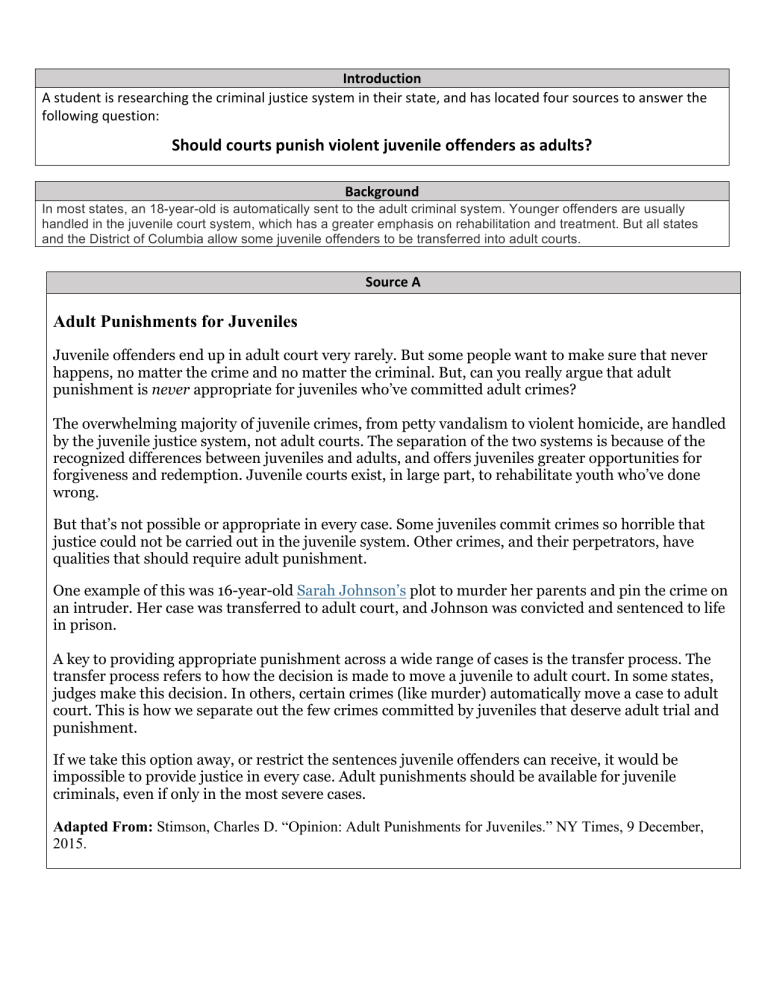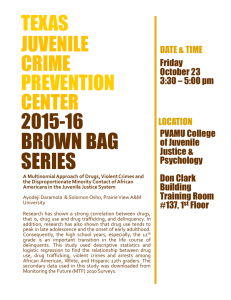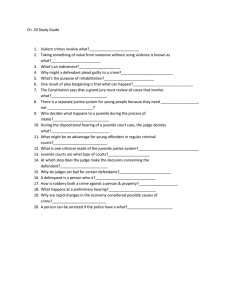
Introduction A student is researching the criminal justice system in their state, and has located four sources to answer the following question: Should courts punish violent juvenile offenders as adults? Background In most states, an 18-­year-­old is automatically sent to the adult criminal system. Younger offenders are usually handled in the juvenile court system, which has a greater emphasis on rehabilitation and treatment. But all states and the District of Columbia allow some juvenile offenders to be transferred into adult courts. Source A Adult Punishments for Juveniles Juvenile offenders end up in adult court very rarely. But some people want to make sure that never happens, no matter the crime and no matter the criminal. But, can you really argue that adult punishment is never appropriate for juveniles who’ve committed adult crimes? The overwhelming majority of juvenile crimes, from petty vandalism to violent homicide, are handled by the juvenile justice system, not adult courts. The separation of the two systems is because of the recognized differences between juveniles and adults, and offers juveniles greater opportunities for forgiveness and redemption. Juvenile courts exist, in large part, to rehabilitate youth who’ve done wrong. But that’s not possible or appropriate in every case. Some juveniles commit crimes so horrible that justice could not be carried out in the juvenile system. Other crimes, and their perpetrators, have qualities that should require adult punishment. One example of this was 16-year-old Sarah Johnson’s plot to murder her parents and pin the crime on an intruder. Her case was transferred to adult court, and Johnson was convicted and sentenced to life in prison. A key to providing appropriate punishment across a wide range of cases is the transfer process. The transfer process refers to how the decision is made to move a juvenile to adult court. In some states, judges make this decision. In others, certain crimes (like murder) automatically move a case to adult court. This is how we separate out the few crimes committed by juveniles that deserve adult trial and punishment. If we take this option away, or restrict the sentences juvenile offenders can receive, it would be impossible to provide justice in every case. Adult punishments should be available for juvenile criminals, even if only in the most severe cases. Adapted From: Stimson, Charles D. “Opinion: Adult Punishments for Juveniles.” NY Times, 9 December, 2015. Source B *Intellectual ability refers to how well a person can reason, plan, think, and communicate. *Psychosocial maturity is measured by reduced impulsivity, improved risk perception, future orientation, and resistance to peer influence. Source: Heidi Mueller, Executive Director, Juvenile Justice Commission, Illinois Department of Human Services. Retrieved From: http://www.dhs.state. il.us/page.aspx?item=64924 Source C Should the U.S. Justice System Treat Juvenile Violent Offenders as Adults? YES • The end result of a crime is the same, no matter the age of the person who commits it. Our justice system has to hold people accountable for their actions. • Harsh sentencing can act as a deterrent to kids who are considering committing crimes. • Light sentences do not teach kids the lesson they need to learn: if you commit a terrible crime, you will spend a considerable part of your life in jail. NO • The juvenile prison system can help kids turn their lives around. Juvenile prisons are much better at rehabilitation than adult facilities – a young person released from a juvenile prison is far less likely to re-commit a crime than someone coming out of an adult facility. • Children don’t have the intellectual or moral ability to understand the consequences of their actions. • Judgements are not fairly applied. Statistically, black juvenile offenders are far more likely to be moved to adult courts (and serve adult time) than their white peers who’ve committed similar crimes. Source Adapted From: Reaves, Jessica. “Should the Law Treat Kids and Adults Differently?” Time Magazine. 17 May, 2001. Source D Source: Parker, Jeff. “Tall Enough for Prison” Florida Today. 2007. Source E Some Juvenile Killers Deserve Adult Justice Our juvenile justice system is not our criminal justice system. Its design and goals are different, and it is staffed by dedicated and committed professionals who breathe life into its goals of balancing the best interests of the community and the best interests of the child. Many young offenders are diverted from the juvenile system before they enter it. Others are brought into the juvenile system because they need enhanced supervision by the courts and increased services. All young people in the juvenile justice system are protected by strict standards of confidentiality that prevent juvenile mistakes from carrying lifelong consequences. However, Some juveniles commit crimes so serious, so heinous, that public safety mandates – and justice demands – full accountability in our criminal justice system. There are those who argue this is unfair and unjust. They say the juvenile brain is not fully developed until well into the 20s. Therefore, they tell us, a juvenile should not be held to the same standards as an adult offender. Experts calling for reform say that three-­‐quarters of adolescents lack the decision-­‐making abilities of an adult. However, this means that one-­‐quarter of juveniles can function in a manner very similar to adults. The experts also acknowledge that they cannot apply the general concepts of the juvenile developing brain to any one specific individual. It is clear that a developing adolescent brain does not prevent deliberate, thoughtful actions. It cannot be an excuse for unspeakable behavior. It cannot be used as a basis for sweeping reform of the juvenile system or to challenge the propriety of addressing the most serious crimes in our criminal justice system. Source: Weir, Peter A. “Some juvenile killers deserve adult justice.” Denver Post, 19 November, 2013. UNIT 4 EBAS – Should courts punish violent juvenile offenders as adults? Name: _______________________ Sourcing Questions ______ 1. Why was Source D most likely created? A. To communicate factual information B. To illustrate a trend C. To entertain D. To make a point ______ 2. Which analysis of Sources A and C are most accurate? A. Sources A and C summarize facts about the juvenile justice system B. Sources A and C provide a point of view about the juvenile justice system C. Sources A and C list the benefits of the juvenile justice system D. Sources A and C criticize the juvenile justice system ______ 3. How do Sources A and C corroborate one another? A. They both provide arguments for why some juveniles should be tried as adults B. They each describe strengths and weaknesses of the juvenile justice system C. They both provide arguments for why juveniles should not be tried as adults D. They both relate adolescent brain development to our juvenile justice system ______ 4. Which question should students first ask about Source B? A. Why is this information organized in a table? B. What is the most important point of view provided? C. What is the source of this information? D. How should these points of view be used? Peter Weir, author of Source E, has served as a District Attorney in Colorado since 2012. In this position, he works for the prosecutor’s office and is in charge of bringing evidence before Grand Juries. ______ 5. How might the information provided above influence the perspective of Source D? A. Since he works for the prosecutor’s office, he would of course be in favor of harsh punishment for juvenile offenders B. Since he works in the prosecutor’s office, he would of course be against harsh punishment for juvenile offenders C. His job is to prosecute juvenile crimes, so this influences what he would write. D. Since he works for the government, we know his writing is reliable. ______ 6. What type of source is Source C? A. Primary B. Secondary C. Visual D. Multimedia Assume that the information provided in Sources A, B, C, and D is credible. Complete the following extended response question: Should courts punish juvenile offenders as adults? • Develop a claim in response to the question • Cite evidence from the provided sources to support your claim • Use your knowledge of government in your response ____________________________________________________________________________________________ ____________________________________________________________________________________________ ____________________________________________________________________________________________ ____________________________________________________________________________________________ ____________________________________________________________________________________________ ____________________________________________________________________________________________ ____________________________________________________________________________________________ ____________________________________________________________________________________________ ____________________________________________________________________________________________ ____________________________________________________________________________________________ ____________________________________________________________________________________________ ____________________________________________________________________________________________ ____________________________________________________________________________________________ ____________________________________________________________________________________________ ____________________________________________________________________________________________ ____________________________________________________________________________________________ ____________________________________________________________________________________________ ____________________________________________________________________________________________ ____________________________________________________________________________________________ ____________________________________________________________________________________________ ____________________________________________________________________________________________ ____________________________________________________________________________________________ ____________________________________________________________________________________________ ____________________________________________________________________________________________ ____________________________________________________________________________________________ ____________________________________________________________________________________________ ____________________________________________________________________________________________ ____________________________________________________________________________________________



